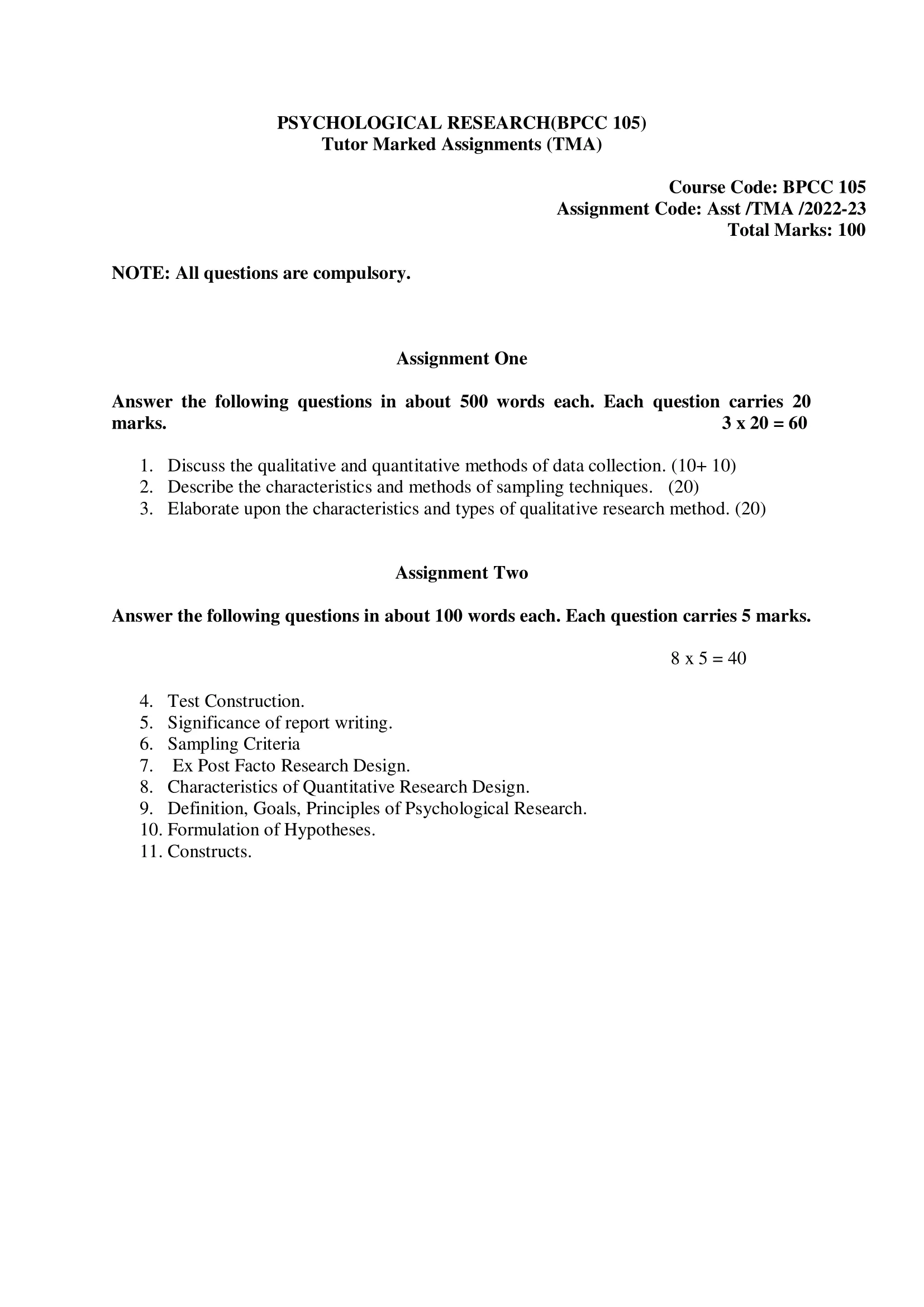Contents
- 1 Assignment One
- 2 Answer the following questions in about 500 words each. Each question carries 20marks.
- 3 1. Discuss the qualitative and quantitative methods of data collection.
- 4 2. Describe the characteristics and methods of sampling techniques.
- 5 3. Elaborate upon the characteristics and types of qualitative research method.
- 6 Assignment Two
- 7 Answer the following questions in about 100 words each. Each question carries 5 marks.
- 8 4. Test Construction.
- 9 5. Significance of report writing.
- 10 6. Sampling Criteria
- 11 7. Ex Post Facto Research Design.
- 12 8. Characteristics of Quantitative Research Design.
- 13 9. Definition, Goals, Principles of Psychological Research.
- 14 10. Formulation of Hypotheses.
- 15 11. Constructs.

| Title | BPCC-105: IGNOU BAG Solved Assignment 2022-2023 |
| University | IGNOU |
| Degree | Bachelor Degree Programme |
| Course Code | BPCC-105 |
| Course Name | PSYCHOLOGICAL RESEARCH |
| Programme Name | Bachelor of Arts (General) |
| Programme Code | BAG |
| Total Marks | 100 |
| Year | 2022-2023 |
| Language | English |
| Assignment Code | Asst /TMA /2022-23 |
| Last Date for Submission of Assignment: | For June Examination: 31st April For December Examination: 30th September |

Assignment One
Answer the following questions in about 500 words each. Each question carries 20
marks.
1. Discuss the qualitative and quantitative methods of data collection.
Ans: Qualitative and quantitative research methods are two fundamental approaches used in data collection in social sciences. The choice of method used depends on the research objectives, the nature of the research problem, and the availability of resources.
Qualitative Research Method Qualitative research is exploratory research that focuses on gaining an understanding of a particular phenomenon. It is based on the collection of non-numerical data such as text, images, or videos, which are then analyzed to derive meaning from the data. Qualitative data can be collected through methods such as in-depth interviews, focus groups, observation, and document analysis.
In-depth interviews are face-to-face conversations between the researcher and the participants. They allow the researcher to gain a deep understanding of the participants’ experiences, beliefs, attitudes, and opinions. Focus groups, on the other hand, involve a group of participants who discuss a particular topic in a moderated discussion. This method is useful for exploring a particular issue from multiple perspectives.
Observation involves the systematic recording of behaviors, events, and interactions in a particular setting. The researcher observes and records the events as they unfold, and then analyzes the data to identify patterns and themes. Finally, document analysis involves the review of existing documents such as government reports, newspapers, and diaries to understand a particular phenomenon.
Quantitative Research Method Quantitative research is an empirical research method that is based on the collection of numerical data. It involves the use of statistical techniques to analyze the data and draw conclusions. The data is collected through structured surveys, questionnaires, or experiments.
Structured surveys and questionnaires involve the use of a pre-determined set of questions to gather data from the participants. This method is useful for collecting data from a large number of participants in a short amount of time. Experiments, on the other hand, involve the manipulation of one or more variables to measure the effect on a dependent variable. This method is useful for establishing causality between variables.
Comparing Qualitative and Quantitative Methods Qualitative and quantitative research methods have their strengths and weaknesses. Qualitative methods are useful for exploring complex phenomena that are difficult to quantify. Qualitative data is rich in detail and can provide insights into the participants’ experiences, attitudes, and behaviors. However, qualitative research is time-consuming and resource-intensive. The data collected may be subjective and difficult to analyze.
Quantitative research methods are useful for establishing causality between variables and generalizing the findings to a larger population. The data collected is objective and can be analyzed using statistical techniques. However, quantitative research may lack the depth and richness of qualitative research. It may also overlook important variables that cannot be quantified.
2. Describe the characteristics and methods of sampling techniques.
Ans: Sampling is the process of selecting a subset of individuals or objects from a larger population to represent the entire population. Sampling techniques are used in research to study the characteristics of a population when it is not feasible to study the entire population. In this answer, we will discuss the characteristics and methods of different sampling techniques.
Characteristics of Sampling Techniques
- Representativeness: A sample is considered to be representative if it accurately reflects the characteristics of the population. The goal of sampling is to achieve this representativeness.
- Randomness: A sample is considered to be random if every member of the population has an equal chance of being selected. Random sampling reduces the potential for bias in the selection of the sample.
- Sample size: The size of the sample should be large enough to ensure that the sample accurately reflects the population. The sample size should also be appropriate for the statistical analysis that will be conducted on the data.
Sampling Methods
- Simple Random Sampling: In simple random sampling, every member of the population has an equal chance of being selected. This method requires a complete list of the population, and individuals are selected at random from this list.
- Stratified Sampling: In stratified sampling, the population is divided into subgroups or strata, based on a specific characteristic such as age or income. A random sample is then selected from each subgroup. Stratified sampling increases the representativeness of the sample, especially when the population is diverse.
- Systematic Sampling: In systematic sampling, individuals are selected at regular intervals from a complete list of the population. For example, if a researcher wanted to select 100 individuals from a population of 1000, they might select every 10th individual on the list.
- Cluster Sampling: In cluster sampling, the population is divided into clusters or groups. A random sample of clusters is then selected, and all individuals within the selected clusters are included in the sample. Cluster sampling is useful when the population is geographically dispersed.
- Convenience Sampling: In convenience sampling, individuals are selected based on their availability or willingness to participate. This method is often used in pilot studies or exploratory research. Convenience sampling is prone to bias because individuals who are easily accessible may not be representative of the population.
- Snowball Sampling: In snowball sampling, participants are recruited through referrals from other participants. This method is useful when the population is difficult to identify or contact.
3. Elaborate upon the characteristics and types of qualitative research method.
Ans: Qualitative research is a method of inquiry that is used to understand the complexities and nuances of human behavior and social phenomena. It is based on the collection of non-numerical data, such as text, images, or videos, which are then analyzed to derive meaning from the data. Qualitative research is exploratory in nature and is often used when the research question is complex or the topic is not well understood. In this answer, we will discuss the characteristics and types of qualitative research methods.
Characteristics of Qualitative Research
- In-depth exploration: Qualitative research is used to gain a deep understanding of a particular phenomenon. The researcher seeks to explore the participants’ experiences, beliefs, attitudes, and opinions in-depth.
- Non-numerical data: Qualitative research is based on the collection of non-numerical data, such as text, images, or videos. The data is analyzed using qualitative methods to identify patterns, themes, and relationships.
- Flexible research design: Qualitative research is flexible and can be adapted to the research question as it evolves. The researcher can modify the research design, data collection methods, and analysis techniques as needed.
- Subjectivity: Qualitative research acknowledges the subjectivity of the researcher and the participants. The researcher’s own biases and preconceptions may influence the research findings.
Types of Qualitative Research Methods
- In-depth interviews: In-depth interviews are face-to-face conversations between the researcher and the participants. They allow the researcher to gain a deep understanding of the participants’ experiences, beliefs, attitudes, and opinions. In-depth interviews can be conducted in person, over the phone, or through video conferencing.
- Focus groups: Focus groups involve a group of participants who discuss a particular topic in a moderated discussion. This method is useful for exploring a particular issue from multiple perspectives. Focus groups are conducted in person and typically last one to two hours.
- Observation: Observation involves the systematic recording of behaviors, events, and interactions in a particular setting. The researcher observes and records the events as they unfold, and then analyzes the data to identify patterns and themes. Observation can be conducted in a naturalistic setting or a laboratory.
- Document analysis: Document analysis involves the review of existing documents such as government reports, newspapers, and diaries to understand a particular phenomenon. The researcher reviews the documents and analyzes the data to identify patterns and themes.
- Case studies: Case studies involve the in-depth examination of a particular case, such as an individual or a specific event. The researcher collects data through multiple methods, such as interviews, observation, and document analysis, and then analyzes the data to understand the case in-depth.
Assignment Two
Answer the following questions in about 100 words each. Each question carries 5 marks.
4. Test Construction.
Ans: Test construction is the process of creating a standardized assessment instrument to measure a particular trait or skill. The construction of a test involves several steps, including defining the purpose of the test, identifying the target population, selecting appropriate items and formats, establishing reliability and validity, and setting scoring procedures. Test constructors need to consider the different types of test items, such as multiple-choice, true/false, short-answer, and essay questions, to ensure that they effectively measure the desired skill or knowledge. Additionally, tests must be designed to avoid biases and ensure fair evaluation for all test-takers. The process of test construction requires careful planning and attention to detail to ensure that the resulting instrument is reliable, valid, and useful for its intended purpose.
5. Significance of report writing.
Ans: Report writing is an important skill that is essential in many fields, including business, government, education, and research. The significance of report writing lies in its ability to communicate information clearly and effectively to a specific audience. Here are some specific reasons why report writing is important:
- Communicating information: Reports provide a structured way of presenting information, making it easier for readers to understand and interpret data. They allow the writer to organize data, analyze it, and present it in a way that is clear and concise.
- Decision-making: Reports often play a key role in decision-making. They can provide critical information that is needed to make informed decisions, and can be used to support or refute a specific course of action.
- Record-keeping: Reports can serve as a permanent record of events, decisions, and actions. This is important for legal and compliance purposes, as well as for reference in the future.
- Accountability: Reports can help hold people or organizations accountable for their actions. They can be used to track progress towards goals, monitor performance, and identify areas that need improvement.
- Professionalism: Reports are often used in professional settings, and the ability to write them well is an important skill. Good report writing can demonstrate a level of professionalism and attention to detail, which can enhance your credibility and reputation.
6. Sampling Criteria
Ans: Sampling criteria are the specific requirements or characteristics that a sample must meet in order to be selected for a research study or survey. The criteria for sampling depend on the nature of the research question and the type of data that needs to be collected. Here are some examples of common sampling criteria:
- Sample size: This refers to the number of individuals or units that need to be included in the sample. The sample size should be large enough to provide statistically valid results but small enough to be feasible to collect data from.
- Demographics: Demographic characteristics such as age, gender, income, education, and geographic location can be important criteria for sampling, depending on the research question. For example, a study on the prevalence of a certain disease may require a sample that represents the age and gender distribution of the population.
- Inclusion/exclusion criteria: These are specific characteristics that determine whether an individual or unit can be included or excluded from the sample. For example, a study on the effectiveness of a new medication may exclude individuals with certain pre-existing medical conditions.
- Randomness: Random sampling is a common method of selecting a sample that ensures that each individual or unit has an equal chance of being selected. Randomness is an important criterion for ensuring the representativeness of the sample.
- Availability: In some cases, the sampling criteria may be influenced by the availability of individuals or units. For example, a study on the effectiveness of a workplace wellness program may only be able to include employees who are currently working for the company.
These are just a few examples of the sampling criteria that may be used in a research study. The specific criteria will depend on the research question, the type of data needed, and other factors related to the study design.
7. Ex Post Facto Research Design.
Ans: Ex post facto research design, also known as retrospective research design, is a type of non-experimental research design that is used to study the relationship between an independent variable and a dependent variable after the fact. In this type of design, the researcher does not manipulate the independent variable but rather observes the effects of the independent variable on the dependent variable based on data that has already been collected.
Ex post facto research design is often used in social sciences and health research when experimental designs are not feasible or ethical. This design is useful when it is not possible to manipulate the independent variable directly, such as when the variable is a naturally occurring event, like a natural disaster or a medical condition. The design is also useful when a randomized controlled trial is not possible, such as when it would be unethical to randomly assign individuals to certain conditions.
Some common examples of ex post facto research design include studies that look at the effects of a specific event or condition, such as the impact of a natural disaster on mental health, the effects of smoking on lung cancer, or the relationship between socioeconomic status and health outcomes.
One of the main challenges of ex post facto research design is the potential for bias due to confounding variables that may have influenced the relationship between the independent and dependent variables. To minimize bias, researchers often use statistical techniques, such as multiple regression analysis, to control for confounding variables.
8. Characteristics of Quantitative Research Design.
Ans: Quantitative research design is a type of research method that involves the collection and analysis of numerical data to answer research questions or test hypotheses. Here are some of the key characteristics of quantitative research design:
- Objective: Quantitative research design aims to be objective, meaning that it is based on empirical evidence and not influenced by personal biases or values. The research questions and hypotheses are formulated to be testable and measurable using numerical data.
- Controlled: Quantitative research design involves a high degree of control over the research setting, variables, and data collection procedures. This is to minimize the potential influence of extraneous variables that could affect the results of the study.
- Standardized: Standardization is a key characteristic of quantitative research design. The data collection instruments, procedures, and sampling methods are standardized to ensure consistency and reliability in the data collection process.
- Large sample size: Quantitative research design often involves a large sample size to increase the statistical power of the study and to ensure that the findings are generalizable to the larger population.
- Statistical analysis: Quantitative research design involves statistical analysis of the numerical data to test hypotheses and draw conclusions. Statistical techniques such as descriptive statistics, inferential statistics, and multivariate analysis are commonly used in quantitative research.
- Causality: Quantitative research design is often used to establish causality, or the relationship between an independent variable and a dependent variable. This is achieved through experimental designs, quasi-experimental designs, or non-experimental designs with control over extraneous variables.
9. Definition, Goals, Principles of Psychological Research.
Ans: Psychological research is the scientific investigation of human behavior and mental processes. It is a systematic and empirical approach to studying human behavior and the factors that influence it. Here are the definition, goals, and principles of psychological research:
- Definition: Psychological research is the systematic and empirical investigation of human behavior and mental processes, including thoughts, emotions, motivations, and actions.
- Goals: The goals of psychological research are to:
- Understand human behavior and mental processes.
- Identify the factors that influence behavior and mental processes.
- Develop and test theories about human behavior and mental processes.
- Develop effective interventions and treatments for psychological problems.
- Contribute to the advancement of psychological knowledge.
- Principles: The principles of psychological research include:
- Objectivity: Psychological research should be conducted objectively, meaning that researchers should approach the investigation without personal biases or preconceptions.
- Reliability: Psychological research should be reliable, meaning that the results should be consistent and repeatable across different studies and research settings.
- Validity: Psychological research should be valid, meaning that it measures what it intends to measure and produces accurate and meaningful results.
- Ethics: Psychological research should be conducted with the utmost ethical standards, which include informed consent, privacy, confidentiality, and protection of participants from harm.
- Scientific rigor: Psychological research should be conducted with scientific rigor, meaning that the research design, methods, and data analysis should be of high quality and adhere to the scientific method.
10. Formulation of Hypotheses.
Ans: A hypothesis is a statement that proposes a relationship between two or more variables. Hypotheses are an essential component of scientific research, as they guide the research process and help researchers to test their theories. In this answer, we will discuss the formulation of hypotheses.
- Identify the research question: A hypothesis is formulated based on the research question. The research question should be specific, clear, and testable. The research question should also be based on a review of the literature and should be relevant to the field of study.
- Identify the variables: A hypothesis proposes a relationship between two or more variables. The independent variable is the variable that is manipulated, while the dependent variable is the variable that is measured.
- Formulate the hypothesis: A hypothesis should be a clear, testable statement that proposes a relationship between two or more variables. The hypothesis should be based on the research question and the review of the literature. The hypothesis should be specific and should be written in a way that allows it to be tested.
- State the null and alternative hypotheses: The null hypothesis is a statement that proposes that there is no relationship between the variables. The alternative hypothesis proposes that there is a relationship between the variables.
- Determine the level of significance: The level of significance is the probability that the results of the study are due to chance. The level of significance is typically set at 0.05, which means that there is a 5% chance that the results are due to chance.
- Determine the type of hypothesis test: There are many different types of hypothesis tests, such as t-tests, ANOVA, and regression analysis. The type of hypothesis test depends on the research question and the type of data being analyzed.
11. Constructs.
Ans: Constructs are abstract concepts that are used to describe or explain phenomena that cannot be directly observed or measured. In research, constructs are used to operationalize and measure complex or abstract concepts, such as attitudes, beliefs, emotions, or intelligence. Constructs are important in research as they allow researchers to measure and compare variables that are difficult to measure directly. To measure constructs, researchers must create measures or tests that are reliable and valid. Constructs can be unidimensional or multidimensional and can be used in various research designs, such as experimental, correlational, or descriptive research. Constructs are a fundamental concept in research and are used in many fields, such as psychology, sociology, and education.
How to Download BPCC-105 Solved Assignment?
You can download it from the www.edukar.in, they have a big database for all the IGNOU solved assignments.
Is the BPCC-105 Solved Assignment Free?
Yes this is absolutely free to download the solved assignment from www.edukar.in
What is the last submission date for BPCC-105 Solved Assignment?
For June Examination: 31st April, For December Examination: 30th October








![[Solved Assignment] BPCS 188-APPLICATIONS OF SOCIAL PSYCHOLOGY (IGNOU-BAG) 2022-2023 BPCS 188-APPLICATIONS OF SOCIAL PSYCHOLOGY IGNOU BAG Solved Assignment 2022-2023](https://edukar.in/wp-content/uploads/2023/01/BPCS-188-APPLICATIONS-OF-SOCIAL-PSYCHOLOGY-IGNOU-BAG-Solved-Assignment-2022-2023-1024x640.webp)







